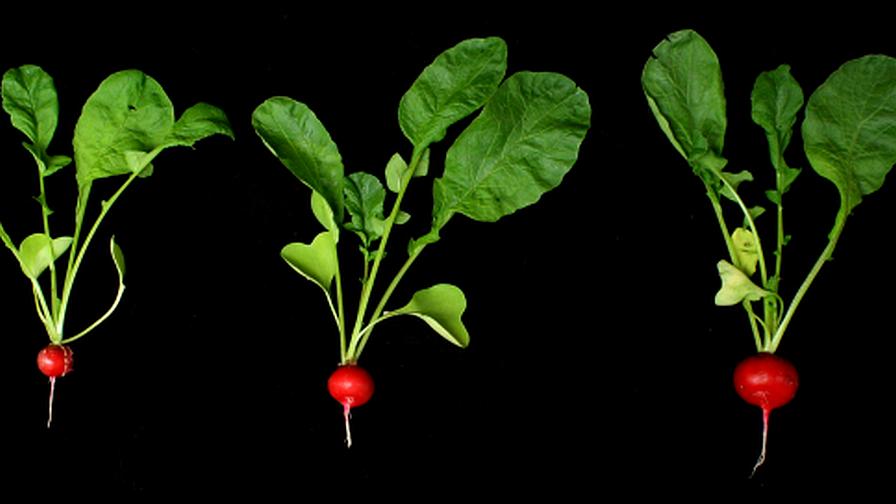Yes, Increasing Light Does Help Improve Yield of Greenhouse Radishes

Spring radishes are not a traditional food crop grown in greenhouses and controlled environments. However, they have potential as a quick-growing crop with productive planting densities and a fast turnaround. In this third installment in our series for GreenhouseGrower.com, we are going to look at how the daily light integral (DLI) influences radish production in controlled environments.
“A 1% increase in light is a 1% increase in yield” is something we commonly hear with respect to food crops and photosynthetic light in controlled environments. Whether it is sole-source electric lighting indoors or shade cloth and supplemental lighting in a greenhouse, successfully managing light to maximize yields begins with understanding how specific crops respond to light.
Our objectives in this study were to characterize how radish growth and development in controlled environments responded to DLI.
Materials and Methods
‘Crunchy King’ and ‘Red Castle’ were selected based on their performance in cultivar trials. Seeds were sown in 72-cell plug trays filled with a commercial soilless substrate and covered with a light covering of coarse vermiculite. After seeding, trays were moved into a glass-glazed greenhouse with a constant air temperature setpoint of 65°F. Seeded trays were placed into one of six identical flood tables, with interior dimensions measuring 36 inches W × 72 inches L × 7.4 inches H. Trays were initially hand-irrigated to saturation with clear water immediately after planting. Flood tables were flooded every morning for the first two weeks, and in the morning and afternoon in the third and fourth week. Each of the different flood trays had their own 40-gallon reservoir filled with a solution consisting of tap water amended with 15-5-15 Cal-Mag (Peters Excel; ICL Specialty Fertilizers, St. Louis, MO) to provide 200 ppm nitrogen.
Each of the six different flood tables were provided with supplemental light from high-pressure sodium lamps to maintain a 16-hour daylength. Additionally, each of the six tables had one of six levels of shade cloth suspended over the top and sides, ranging from 0% (no shade cloth) up to 83% shade. The combination of supplemental lighting and shade cloths created six different DLIs each time the experiment was run, and by repeating the experiment several times throughout the year as the solar DLI fluctuated, we were able to achieve DLIs ranging from approximately 2 to 22 mol·m–2·d–1.
We collected data four weeks after seeds were sewn. The diameter and fresh weight of trimmed and washed radishes were recorded, and additional radishes were graded by hypocotyl diameter according to USDA grading standards.

Supplemental light and radishes go well together. In trials, ‘Crunchy King’ radish had the largest diameter between 12 and 15 mol·m–2·d–1.
Graphics: Christopher Currey
Our Results
‘Crunchy King’ and ‘Red Castle’ radish showed a clear response to DLI after four weeks with DLI. The diameter of radishes increased with DLI as it increased and were largest between 12 and 15 mol·m–2·d–1 for both cultivars. As DLI increased above this, root diameter diminished. The distribution in USDA grades followed the same trend as diameter, with grades increasing and decreasing commensurately. The percentage of damaged roots — usually cracks — increased as the DLI increased above 15 mol·m–2·d–1. Fresh weight followed a similar trend as diameter and grade, with weight increasing with DLI up to 13 to 15 mol·m–2·d–1. Radish foliage also exhibited responses to DLI. As DLI increased up to ~12 mol·m–2·d–1 leaf length increased, but as DLI increased above that leaves were shorter. Additionally, as the DLI increased above 14 mol·m–2·d–1, leaves became lighter green in color.
Shining Light on Management Tactics
The fact that increasing light improves radish yields shouldn’t come as a surprise. But what is interesting and — more importantly — useful, are the specific responses to DLI that can improve how we manage photosynthetic light for radish production in controlled environments.
For more, continue reading at GreenhouseGrower.com.









